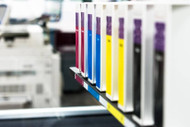The Impact of Ink Cartridge Quality on Document Archiving
Document archiving is a crucial aspect of many businesses and organizations. It involves storing and preserving important documents for long periods, ensuring they remain legible and usable over time. When it comes to document archiving, the quality of ink cartridges used for printing plays a significant role. Here's a closer look at how ink cartridge quality impacts document archiving.
- Fade Resistance: Ink cartridge quality directly affects the fade resistance of printed documents. High-quality ink cartridges are designed to produce prints that are resistant to fading over time. They contain pigments or dyes that are specifically formulated to withstand the effects of light exposure and environmental factors. Using low-quality or incompatible ink cartridges may result in prints that fade more quickly, compromising the legibility and longevity of archived documents.
- Longevity: Archiving documents involves storing them for an extended period. The longevity of printed documents depends on the durability and stability of the ink used. High-quality ink cartridges are engineered to provide long-lasting prints that can withstand the test of time. They are less prone to smudging, bleeding, or discoloration, ensuring that archived documents remain legible and retain their original quality.
- Acid-Free Inks: Acidic components in ink can cause paper degradation over time. To prevent this, acid-free inks are used in high-quality ink cartridges. Acid-free inks have a neutral pH level, minimizing the risk of paper yellowing or deteriorating over time. When archiving documents, using ink cartridges with acid-free inks is crucial for preserving the integrity of the paper and ensuring long-term readability.
- Consistency and Color Accuracy: Ink cartridge quality plays a significant role in achieving consistent and accurate color reproduction. When archiving documents, it's essential to maintain color integrity to ensure that information, graphs, and images are accurately represented. High-quality ink cartridges provide consistent color output, minimizing variations and color shifts that can occur over time. This ensures that archived documents maintain their visual accuracy and readability.
- Document Legibility: The quality of ink used in printing directly impacts the legibility of archived documents. Inconsistent ink flow, poor ink distribution, or low-quality inks can result in uneven print quality, making text and images difficult to read. High-quality ink cartridges provide consistent ink flow and produce sharp, clear prints, ensuring that archived documents remain legible and usable throughout their lifespan.
- Document Preservation: Proper document preservation involves storing documents in controlled environments that maintain optimal conditions for long-term preservation. However, even with ideal storage conditions, the quality of ink used in printing can affect document preservation. High-quality ink cartridges help mitigate risks associated with ink degradation, such as ink bleeding or ink seeping into the paper fibers, which can compromise document integrity. Using high-quality ink ensures that documents maintain their original appearance and readability, even under challenging preservation conditions.
Conclusion:
the quality of ink cartridges used for document printing significantly impacts document archiving. Fade resistance, longevity, acid-free inks, consistent color reproduction, legibility, and document preservation are all factors affected by ink cartridge quality. Investing in high-quality ink cartridges ensures that archived documents remain legible, visually accurate, and durable over time. When it comes to document archiving, it's crucial to prioritize ink cartridge quality to ensure the long-term preservation and accessibility of important information.





